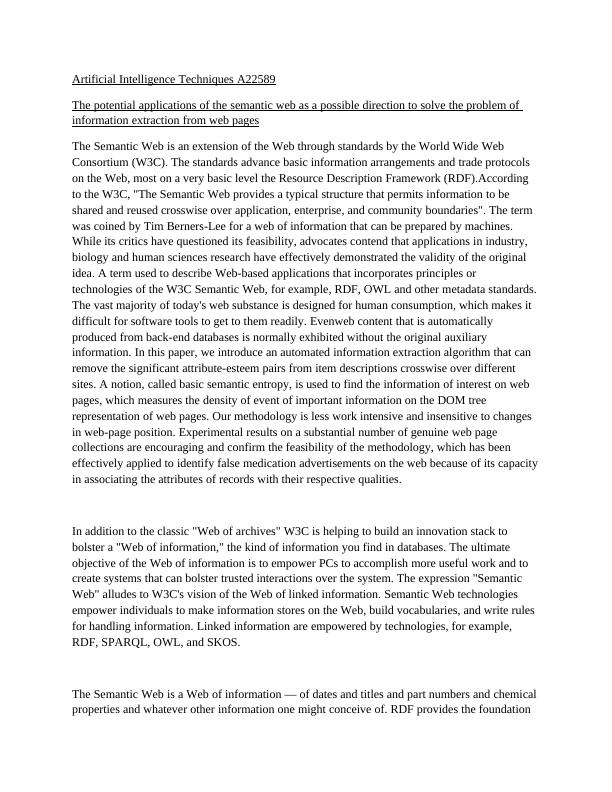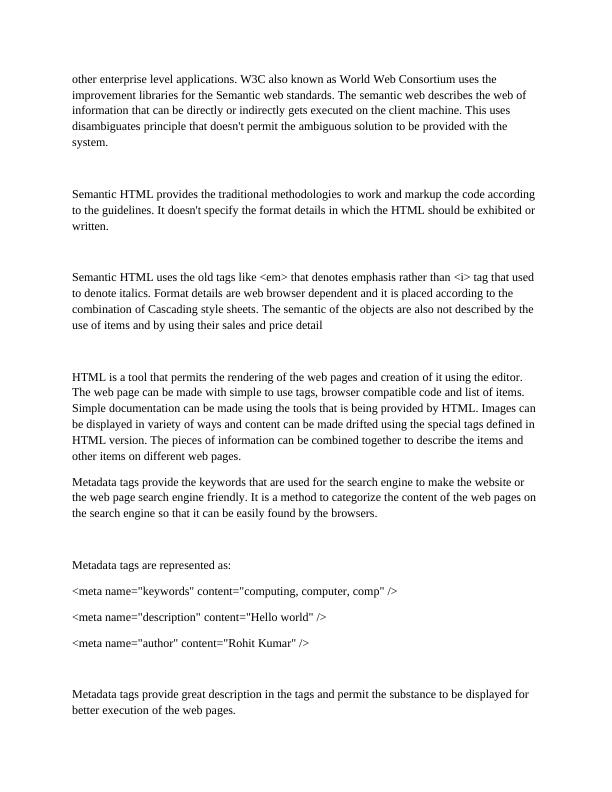Ask a question from expert
Artificial Intelligence Techniques Assignment
10 Pages3438 Words255 Views
Added on 2020-01-28
Artificial Intelligence Techniques Assignment
Added on 2020-01-28
BookmarkShareRelated Documents
Artificial Intelligence Techniques A22589The potential applications of the semantic web as a possible direction to solve the problem of information extraction from web pagesThe Semantic Web is an extension of the Web through standards by the World Wide Web Consortium (W3C). The standards advance basic information arrangements and trade protocols on the Web, most on a very basic level the Resource Description Framework (RDF).According to the W3C, "The Semantic Web provides a typical structure that permits information to be shared and reused crosswise over application, enterprise, and community boundaries". The term was coined by Tim Berners-Lee for a web of information that can be prepared by machines. While its critics have questioned its feasibility, advocates contend that applications in industry, biology and human sciences research have effectively demonstrated the validity of the original idea. A term used to describe Web-based applications that incorporates principles or technologies of the W3C Semantic Web, for example, RDF, OWL and other metadata standards. The vast majority of today's web substance is designed for human consumption, which makes it difficult for software tools to get to them readily. Evenweb content that is automatically produced from back-end databases is normally exhibited without the original auxiliary information. In this paper, we introduce an automated information extraction algorithm that can remove the significant attribute-esteem pairs from item descriptions crosswise over different sites. A notion, called basic semantic entropy, is used to find the information of interest on web pages, which measures the density of event of important information on the DOM tree representation of web pages. Our methodology is less work intensive and insensitive to changes in web-page position. Experimental results on a substantial number of genuine web page collections are encouraging and confirm the feasibility of the methodology, which has been effectively applied to identify false medication advertisements on the web because of its capacityin associating the attributes of records with their respective qualities. In addition to the classic "Web of archives" W3C is helping to build an innovation stack to bolster a "Web of information," the kind of information you find in databases. The ultimate objective of the Web of information is to empower PCs to accomplish more useful work and to create systems that can bolster trusted interactions over the system. The expression "Semantic Web" alludes to W3C's vision of the Web of linked information. Semantic Web technologies empower individuals to make information stores on the Web, build vocabularies, and write rules for handling information. Linked information are empowered by technologies, for example, RDF, SPARQL, OWL, and SKOS. The Semantic Web is a Web of information — of dates and titles and part numbers and chemical properties and whatever other information one might conceive of. RDF provides the foundation

for publishing and linking your information. Various technologies permit you to embed information in records (RDFa, GRDDL) or uncover what you have in SQL databases, or make it available as RDF files. The word semantic itself implies meaning or understanding. In that capacity, the essential difference between Semantic Web technologies and other technologies identified with information, (for example, relational databases or the World Wide Web itself) is that the Semantic Web is worried with the meaning and not the structure of information. The Semantic Web is an idea of World Wide Web inventor Tim Berners-Lee that the Web all in all can be made more intelligent and maybe even intuitive about how to serve a user's needs. Berners-Lee watches that in spite of the fact that internet searchers index a significant part of the Web's substance, they have little ability to choose the pages that a user truly needs or needs. He anticipates various courses in which engineers and creators, singly or in collaborations, can use self-descriptions and other techniques so that setting understanding projects can selectively find what users need. This crucial difference causes a totally different attitude toward how storing, querying, and displaying information might be drawn nearer. A few applications, for example, those that alludeto a lot of information from a wide range of sources, benefit colossally from this component. Others, for example, the storage of high volumes of highly organized transactional information, don't. Semantic web permitted the user to find, share and combine the information to exchange it starting with one place then onto the next easily. It permits the working of current web and makes it more secure and usable by showing the information. The users are permitted to use the Web for carrying out the undertakings of finding the folder or categories and it just makes it simple. Semantic web provides the instructions for the machine to execute the assignments by providing the interpreter that can interpret it. machines can perform the undertaking provided by the Semantic Web and it involves finding, combining and acting on the information that is available on the web. Semantic Web provides system on which the applications can be made and created using the tools. It permits the information to be shared and reused between numerous applications and

other enterprise level applications. W3C also known as World Web Consortium uses the improvement libraries for the Semantic web standards. The semantic web describes the web of information that can be directly or indirectly gets executed on the client machine. This uses disambiguates principle that doesn't permit the ambiguous solution to be provided with the system. Semantic HTML provides the traditional methodologies to work and markup the code according to the guidelines. It doesn't specify the format details in which the HTML should be exhibited or written. Semantic HTML uses the old tags like <em> that denotes emphasis rather than <i> tag that used to denote italics. Format details are web browser dependent and it is placed according to the combination of Cascading style sheets. The semantic of the objects are also not described by the use of items and by using their sales and price detail HTML is a tool that permits the rendering of the web pages and creation of it using the editor. The web page can be made with simple to use tags, browser compatible code and list of items. Simple documentation can be made using the tools that is being provided by HTML. Images can be displayed in variety of ways and content can be made drifted using the special tags defined in HTML version. The pieces of information can be combined together to describe the items and other items on different web pages.Metadata tags provide the keywords that are used for the search engine to make the website or the web page search engine friendly. It is a method to categorize the content of the web pages on the search engine so that it can be easily found by the browsers.Metadata tags are represented as:<meta name="keywords" content="computing, computer, comp" /><meta name="description" content="Hello world" /><meta name="author" content="Rohit Kumar" />Metadata tags provide great description in the tags and permit the substance to be displayed for better execution of the web pages.

End of preview
Want to access all the pages? Upload your documents or become a member.
Related Documents
Semantic Information Demonstrates PDFlg...
|22
|7036
|384
The Future Impact of Blockchain on Big Data- Assignmentlg...
|8
|1537
|140